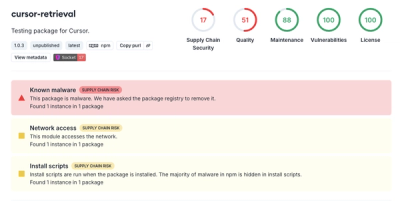
Research
Security News
Malicious PyPI Package ‘pycord-self’ Targets Discord Developers with Token Theft and Backdoor Exploit
Socket researchers uncover the risks of a malicious Python package targeting Discord developers.
@fluidframework/aqueduct
Advanced tools
A set of implementations for Fluid Framework interfaces.
When taking a dependency on a Fluid Framework library's public APIs, we recommend using a ^ (caret) version range, such as ^1.3.4.
While Fluid Framework libraries may use different ranges with interdependencies between other Fluid Framework libraries,
library consumers should always prefer ^.
If using any of Fluid Framework's unstable APIs (for example, its beta APIs), we recommend using a more constrained version range, such as ~.
To get started, install the package by running the following command:
npm i @fluidframework/aqueduct
This package leverages package.json exports to separate its APIs by support level. For more information on the related support guarantees, see API Support Levels.
To access the public (SemVer) APIs, import via @fluidframework/aqueduct like normal.
To access the legacy APIs, import via @fluidframework/aqueduct/legacy.
API documentation for @fluidframework/aqueduct is available at https://fluidframework.com/docs/apis/aqueduct.

The Aqueduct is a library for building Fluid objects and Fluid containers within the Fluid Framework. Its goal is to provide a thin base layer over the existing Fluid Framework interfaces that allows developers to get started quickly.
Fluid object development consists of developing the data object and the corresponding data object factory. The data object defines the logic of your Fluid object, whereas the data object factory defines how to initialize your object.
DataObject and PureDataObject are the two base classes provided by the library.
The DataObject class extends PureDataObject and provides the following additional functionality:
root SharedDirectory that makes creating and storing distributed data structures and objects easy.Note: Most developers will want to use the DataObject as their base class to extend.
PureDataObject provides the following functionality:
initializingFirstTime(props: S) - called only the first time a Fluid object is initialized and only on the first
client on which it loads.initializingFromExisting() - called every time except the first time a Fluid object is initialized; that is, every
time an instance is loaded from a previously created instance.hasInitialized() - called every time after initializingFirstTime or initializingFromExisting executesNote: You probably don't want to inherit from this data object directly unless you are creating another base data object class. If you have a data object that doesn't use distributed data structures you should use Container Services to manage your object.
In the below example we have a simple data object, Clicker, that will render a value alongside a button the the page.
Every time the button is pressed the value will increment. Because this data object renders to the DOM it also extends
IFluidHTMLView.
export class Clicker extends DataObject implements IFluidHTMLView {
public static get Name() { return "clicker"; }
public get IFluidHTMLView() { return this; }
private _counter: SharedCounter | undefined;
protected async initializingFirstTime() {
const counter = SharedCounter.create(this.runtime);
this.root.set("clicks", counter.handle);
}
protected async hasInitialized() {
const counterHandle = this.root.get<IFluidHandle<SharedCounter>>("clicks");
this._counter = await counterHandle.get();
}
public render(div: HTMLElement) {
ReactDOM.render(
<CounterReactView counter={this.counter} />,
div,
);
return div;
}
private get counter() {
if (this._counter === undefined) {
throw new Error("SharedCounter not initialized");
}
return this._counter;
}
}
The DataObjectFactory is used to create a Fluid object and to initialize a data object within the context of a
Container. The factory can live alongside a data object or within a different package. The DataObjectFactory defines
the distributed data structures used within the data object as well as any Fluid objects it depends on.
The Aqueduct offers a factory for each of the data objects provided.
In the below example we build a DataObjectFactory for the Clicker example above. To build a
DataObjectFactory, we need to provide factories for the distributed data structures we are using inside of our
DataObject. In the above example we store a handle to a SharedCounter in this.root to track our "clicks". The
DataObject comes with the SharedDirectory (this.root) already initialized, so we just need to add the factory for
SharedCounter.
export const ClickerInstantiationFactory = new DataObjectFactory(
Clicker.Name,
Clicker,
[SharedCounter.getFactory()], // distributed data structures
{}, // Provider Symbols see below
);
This factory can then create Clickers when provided a creating instance context.
const myClicker = ClickerInstantiationFactory.createInstance(this.context) as Clicker;
The this.providers object on PureDataObject is initialized in the constructor and is generated based on Providers
provided by the Container. To access a specific provider you need to:
PureDataObject/DataObjectIn the below example we have an IFluidUserInfo interface that looks like this:
interface IFluidUserInfo {
readonly userCount: number;
}
On our example we want to declare that we want the IFluidUserInfo Provider and get the userCount if the Container
provides the IFluidUserInfo provider.
export class MyExample extends DataObject<IFluidUserInfo> {
protected async initializingFirstTime() {
const userInfo = await this.providers.IFluidUserInfo;
if(userInfo) {
console.log(userInfo.userCount);
}
}
}
// Note: we have to define the symbol to the IFluidUserInfo that we declared above. This is compile time checked.
export const ClickerInstantiationFactory = new DataObjectFactory(
Clicker.Name
Clicker,
[], // distributed data structures
{IFluidUserInfo}, // Provider Symbols see below
);
A Container is a collection of data objects and functionality that produce an experience. Containers hold the instances of data objects as well as defining the data objects that can be created within the Container. Because of this data objects cannot be consumed except for when they are within a Container.
The Aqueduct library provides the ContainerRuntimeFactoryWithDefaultDataStore that enables you as a container developer to:
In the below example we will write a Container that exposes the above Clicker using the Clicker Factory. You will notice below that the Container developer defines the registry name (data object type) of the Fluid object. We also pass in the type of data object we want to be the default. The default data object is created the first time the Container is created.
export fluidExport = new ContainerRuntimeFactoryWithDefaultDataStore(
ClickerInstantiationFactory.type, // Default data object type
ClickerInstantiationFactory.registryEntry, // Fluid object registry
[], // Provider Entries
[], // Request Handler Routes
);
You can provide custom request handlers to the container. These request handlers are injected after system handlers but
before the DataObject get function. Request handlers allow you to intercept requests made to the container and return
custom responses.
Consider a scenario where you want to create a random color generator. I could create a RequestHandler that when someone
makes a request to the Container for {url:"color"} will intercept and return a custom IResponse of { status:200, type:"text/plain", value:"blue"}.
We use custom handlers to build the Container Services pattern.
These are the platform requirements for the current version of Fluid Framework Client Packages. These requirements err on the side of being too strict since within a major version they can be relaxed over time, but not made stricter. For Long Term Support (LTS) versions this can require supporting these platforms for several years.
It is likely that other configurations will work, but they are not supported: if they stop working, we do not consider that a bug. If you would benefit from support for something not listed here, file an issue and the product team will evaluate your request. When making such a request please include if the configuration already works (and thus the request is just that it becomes officially supported), or if changes are required to get it working.
strict options are supported.strictNullChecks is required.exactOptionalPropertyTypes is currently not fully supported.
If used, narrowing members of Fluid Framework types types using in, Reflect.has, Object.hasOwn or Object.prototype.hasOwnProperty should be avoided as they may incorrectly exclude undefined from the possible values in some cases.Node16, NodeNext, or Bundler resolution should be used with TypeScript compilerOptions to follow the Node.js v12+ ESM Resolution and Loading algorithm.
Node10 resolution is not supported as it does not support Fluid Framework's API structuring pattern that is used to distinguish stable APIs from those that are in development.
ES Modules: ES Modules are the preferred way to consume our client packages (including in NodeJs) and consuming our client packages from ES Modules is fully supported.
CommonJs: Consuming our client packages as CommonJs is supported only in NodeJS and only for the cases listed below. This is done to accommodate some workflows without good ES Module support. If you have a workflow you would like included in this list, file an issue. Once this list of workflows motivating CommonJS support is empty, we may drop support for CommonJS one year after notice of the change is posted here.
There are many ways to contribute to Fluid.
Detailed instructions for working in the repo can be found in the Wiki.
This project has adopted the Microsoft Open Source Code of Conduct. For more information see the Code of Conduct FAQ or contact opencode@microsoft.com with any additional questions or comments.
This project may contain Microsoft trademarks or logos for Microsoft projects, products, or services. Use of these trademarks or logos must follow Microsoft’s Trademark & Brand Guidelines. Use of Microsoft trademarks or logos in modified versions of this project must not cause confusion or imply Microsoft sponsorship.
Not finding what you're looking for in this README? Check out fluidframework.com.
Still not finding what you're looking for? Please file an issue.
Thank you!
This project may contain Microsoft trademarks or logos for Microsoft projects, products, or services.
Use of these trademarks or logos must follow Microsoft's Trademark & Brand Guidelines.
Use of Microsoft trademarks or logos in modified versions of this project must not cause confusion or imply Microsoft sponsorship.
FAQs
A set of implementations for Fluid Framework interfaces.
We found that @fluidframework/aqueduct demonstrated a healthy version release cadence and project activity because the last version was released less than a year ago. It has 0 open source maintainers collaborating on the project.
Did you know?

Socket for GitHub automatically highlights issues in each pull request and monitors the health of all your open source dependencies. Discover the contents of your packages and block harmful activity before you install or update your dependencies.

Research
Security News
Socket researchers uncover the risks of a malicious Python package targeting Discord developers.

Security News
The UK is proposing a bold ban on ransomware payments by public entities to disrupt cybercrime, protect critical services, and lead global cybersecurity efforts.

Security News
Snyk's use of malicious npm packages for research raises ethical concerns, highlighting risks in public deployment, data exfiltration, and unauthorized testing.